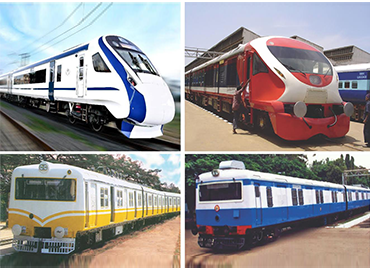What is Air Suspension system?
Air suspension is a form of vehicle suspension that is operated by electric motor
or drive shaft driven Air Compressor. The flexible Rubber Bellows, usually made
of laminated or reinforced Rubber, are filled with compressed air. Air
suspension systems, as compared to conventional suspension systems with Helical
Steel Springs, employ air-filled bellows called air springs as an elastic medium
to bear the weight of the vehicle, cushion road shocks and provide a smoother
riding in the journey.
Basic Components of air suspension system:
- Air Springs: Air Springs are the foundation of
the system, substituting conventional helical coil or leaf springs. These
flexible rubber bellows can be filled or emptied with air to change the
vehicle's suspension height.
- Compressor: Powered by either electric motor or
engine unit, this device produces the compressed air necessary for inflating
the air springs.
- Supply Lines: These carry compressed air from the
compressor to the air spring.
- Valves: Valves control the airflow in the air
springs in order to make precise adjustments.
- Air Reservoir: An air reservoir or air tank holds
compressed air for the suspension system, allowing for rapid height changes
and a more comfortable driving experience.
- Air Filters: To keep impurities out of the air
springs and preserve smooth operation, an air filter filters the
compressor’s incoming air.
- Electronic Control Unit (ECU): Manages the system
through sensors that monitor and adjust the air pressure in the springs to
maintain the desired ride height and comfort.
- Height sensors: Height sensors identify the gap
between the vehicle body and its wheels, providing data to the ECU so that
the air springs can be adjusted accurately.
Working procedure:
The ECU uses information from height sensors to control the air pressure in the
air springs through the compressor and valves. This allows the system to
maintain a steady ride height even when the load changes. These advanced systems
can adjust each wheel individually, enhancing control and stability.
Advantages for Air suspensions:
- Comfort While Riding: Air suspension systems
provide a more comfortable ride as compared
to conventional suspension systems. Regulating the air pressure in the
springs it enhances the
absorption of bumps and cracks on the track providing smooth journey with a
better ride index.
- Adjustable Vehicle Height for Optimal Driving
Conditions : It provide drivers the flexibility
to adjust the vehicle's height for various driving conditions. For example,
reducing the height of
a vehicle when driving at high speeds can improve its aerodynamics and fuel
efficiency,
whereas increasing it can provide better ground clearance for off-road
driving.
- Load Levelling: The system is able to
automatically adapt in order to keep a consistent ride
height, even with heavy loads on the vehicle. This is feature is very useful
for heavy vehicles
like Trucks, SUVs and Trains.
- Enhanced handling: The system can improve the
vehicle's handling by adjusting the stiffness
of the air springs, resulting in a more stable and controlled ride.
Disadvantages for Air suspensions:
- Expenses: Costs for installing and maintaining
air suspension systems are usually higher than
those for conventional suspension systems that use helical springs. The
total expenses rise
because of the components and technology required.
- Complications: The intricacy of the system may
result in increased maintenance needs and
possible reliability concerns. Certain parts such as compressors and
electronic controls may
experience malfunctions, necessitating specific repairs.
- Durability: Rubber air springs may wear out over
time and require more frequent replacement
compared to steel springs.
- Functionality in Harsh Conditions: Air suspension
systems may experience decreased
performance because rubber parts deteriorate more quickly due to performance
in extreme
temperatures or harsh environments.
Application of Air Suspensions:
- Automobiles: Offers improved comfort and superior
control, particularly in high-end cars and SUVs.
- Heavy-duty trucks and buses: Provides a
comfortable experience during long periods of travel and is capable of
effectively managing heavy loads.
- Railways: Used in trains to provide a smoother
journey by minimizing vibrations and optimize ride index
- Industrial machinery: Assists in decreasing
vibration and noise, enhancing the durability and efficiency of the
equipment.



